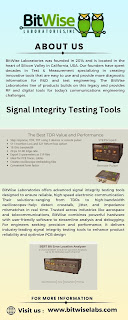Customizable PRBS Pattern Generator: Bitwise Laboratories' Solution for Reliable Communication Testing
PRBS patterns are sequences
that emulate random binary data over a defined length. These sequences, such as
PRBS7, PRBS15, or PRBS31, are highly beneficial for verifying communication
channels and identifying potential weaknesses in digital systems. Each PRBS
type represents a different sequence length, impacting its suitability for
specific testing scenarios. For instance, longer sequences like PRBS15 or
PRBS31 provide a more comprehensive representation of random data, making them
effective for rigorous data handling and signal error checking.
At Bitwise Laboratories, PRBS
sequences are utilized to test digital communication systems for resilience and
performance. The use of different sequence lengths allows engineers to select
the most suitable PRBS type based on testing requirements and desired accuracy.
In digital communication and
hardware testing, Pseudo-Random Binary Sequences (PRBS) are indispensable for
evaluating system robustness. PRBS patterns are deterministic sequences of
binary values (0s and 1s) that, while repeatable, appear random. These
sequences play a vital role in testing signal integrity, data channels, and
communication links. Bitwise Laboratories leverages PRBS
pattern generator to help assess and ensure the quality of various
digital systems under realistic data conditions. This article explores how PRBS
patterns are generated, their design, and how Bitwise Laboratories applies them
to achieve thorough testing and analysis.
PRBS Pattern Generator Architecture
A PRBS
pattern generator typically employs shift registers and feedback loops,
where selected bits are combined and fed back into the initial register. This
setup creates a deterministic yet pseudo-random pattern based on the chosen
polynomial. Each PRBS sequence, such as PRBS7 or PRBS15, has a specific
polynomial that determines its length and feedback configuration.
Core Elements of PRBS
Generation:
- Shift
Registers: A sequence of storage units that shift bits
sequentially with each clock pulse.
- Feedback
Mechanism: XOR gates combine outputs from specified shift
registers and feed them back to the initial register.
- Seed
Initialization: An initial non-zero seed that starts the
PRBS sequence.
For instance, in a PRBS7
generator, the polynomial is used, where the feedback
taps are at the 7th and 6th positions. These bits are XORed together and fed
back to the first register. The pattern created will repeat after 127 bits,
ideal for short-term tests, while PRBS15 (with a 32,767-bit length) is more
suited for long-term and intensive testing.
Generating PRBS Patterns
The PRBS generation process
can be described in a few straightforward steps:
- Initialization:
Load a seed value into the shift registers.
- Shifting:
Shift all bits one position right with each clock pulse.
- Feedback:
XOR specific register outputs and loop the result back into the initial
register.
- Output:
Read the final register’s value as the generated PRBS bit.
This method generates a
sequence that, though deterministic, mimics randomness, providing an ideal tool
for assessing data integrity under real-world conditions.
Testing Applications at
Bitwise Laboratories
Bitwise Laboratories employs
PRBS sequences across several testing applications:
- Signal
Integrity Verification: PRBS patterns simulate data
traffic to detect issues like jitter, bit errors, and signal degradation.
- Hardware
Stress Testing: Feeding PRBS patterns into hardware
devices helps assess performance under randomized data conditions.
- Protocol
and Error Checking Validation: PRBS testing helps verify
data handling protocols and error-detection mechanisms within
communication systems.
Tailoring PRBS Generators to Specific Testing Needs
Customization is critical in
PRBS testing, and Bitwise Laboratories understands the importance of adaptable
PRBS generators. With options to modify sequence length, polynomial
configurations, and initial seed values, Bitwise Laboratories can create PRBS
sequences that meet a variety of communication system requirements. This
flexibility enhances the accuracy and depth of testing, providing insight into
the system’s real-world performance.
In conclusion, PRBS pattern
generator are essential in testing digital communication systems for
reliability and robustness. At Bitwise Laboratories, our PRBS solutions are
designed to accommodate diverse testing needs, from signal integrity to error
checking and data handling validation. By simulating real-world conditions
through adaptable PRBS patterns, Bitwise Laboratories helps clients achieve
optimal performance and reliability in their digital systems.
Visit us : www.bitwiselabs.com

.png)


Comments
Post a Comment